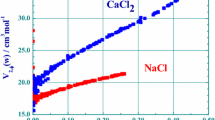Abstract
The storage, retrieval, and manipulation of thermodynamic data with the aid of a computer requires accurate analytical representation of thermodynamic properties of solutions. In the present paper, a critical assessment is made of simple power series expansions and their limitations in representing thermodynamic properties over the entire composition range of a binary system. The advantages of certain orthogonal series as an alternative method of representation is also discussed. Particular emphasis is placed upon series representations which use Legendre polynomials due to their simplicity and the fact that their functional form is consistent with empirical observations of solution behavior. Since the coefficients of orthogonal series are independent of each other when the entire composition range of a binary system is represented, any thermodynamic property can be fitted to any desired degree of accuracy by a finite number of terms without the necessity of storing a large number of significant digits. Also, because the coefficients are uncorrelated, they are amenable to mathematical interpolation and extrapolation as well as to physical interpretation. The relationships between coefficients of series expansions of all partial and integral properties for the general case have been derived using the Gibbs-Duhem equation.
Similar content being viewed by others
Abbreviations
- an :
-
n-th coefficient of series expansion of αA
- bn :
-
w-th coefficient of series expansion of αB
- Cnn-th :
-
coefficient of a general orthogonal series expansion
- C :
-
constant of integration
- f (x) :
-
general function ofx
- F(n, k) :
-
function defined in Eq. [A18]
- gE :
-
integral molar excess free energy
- gEi :
-
partial molar excess free energy of component
- Δh:
-
relative integral molar enthalpy
- Δhi :
-
partial relative molar enthalpy of componenti
- ń:
-
upper summation limit of summation index w
- N(n) :
-
an upper summation limit defined in Eq. [A17]
- Pn(x) :
-
w-th Legendre polynomial
- qn :
-
n-th coefficient of series expansion of αint
- R :
-
Gas constant (1.987 cal mole-1 deg-1)
- sE :
-
integral molar excess entropy
- sEi :
-
partial molar excess entropy of componenti
- T :
-
temperatuve (Kelvin)
- T n :
-
(x) n-th Chebyshev polynomial
- W(n) :
-
normalization factor of the w-th term of an orthogonal set
- x :
-
general independent variable
- Xi :
-
mole fraction of componenti
- αi :
-
alpha function of the partial molar excess prop erty of componenti. αi = ωEi/(l -Xi)
- α int :
-
alpha function of the integral molar excess property, αint = ωE/XAXB
- θn :
-
n-th coefficient of series expansion of the stability function
- ξn :
-
w-th coefficient of an expansion obtained by a least squares analysis
- •p :
-
root mean square deviation of a least squares regression analysis
- Φn(x) :
-
w-th function of an orthogonal set of functions
- ψ :
-
stability function
- ω:
-
any relative integral molar property
- ωi :
-
any relative partial molar property of componenti
- ωE :
-
any integral molar excess property
- ωEi :
-
any partial molar excess property of componenti
References
M. Margules:Sitz-Ber. Math.-Naturw. Kl. Bayer. Akad. Wiss. München Ha, 1895, vol. 104, p. 1243.
A. D. Pelton and S. N. Flengas:J. Electrochem. Soc., 1970, vol. 117, pp. 1130–40.
L. S. Darken:Trans. TMS-AIME, 1967, vol. 239, p. 80.
A. E. Taylor:Advanced Calculus, pp. 711–56, Ginn and Company, Toronto, 1955.
J. L. Holm and O. J. Kleppa:Inorg. Chem., 1969, vol. 8, p. 207.
R. Hultgren, R. L. Orr, P. D. Anderson, and K. K. Kelley:Selected Values of Thermodynamic Properties of Metals and Alloys, John Wiley, N.Y., 1963.
C. H. P. Lupis and H. Gaye:Proceedings of the International Symposium on Metallurgical Chemistry, HMSO, London, 1972, pp. 469–82, (SBN 11 480026 X’).
T. Ostvold:Acta Chem. Scand., 1969, vol. 23, p. 688.
O. Williams:Trans. TMS-AIME, 1969, vol. 245, pp. 2565–70.
Author information
Authors and Affiliations
Rights and permissions
About this article
Cite this article
Bale, C.W., Pelton, A.D. Mathematical representation of thermodynamic properties in binary systems and solution of Gibbs-Duhem Equation. Metall Trans 5, 2323–2337 (1974). https://doi.org/10.1007/BF02644013
Received:
Published:
Issue Date:
DOI: https://doi.org/10.1007/BF02644013




